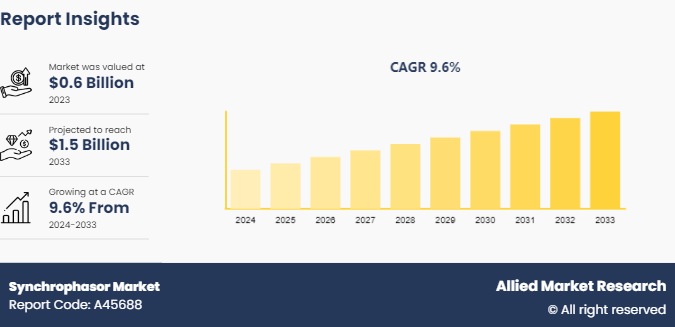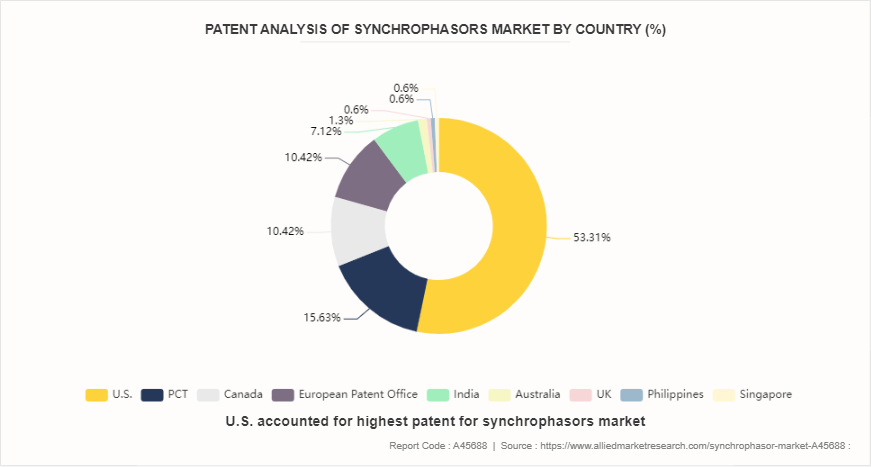Synchrophasor Market Research, 2033
The global synchrophasor market size was valued at $0.6 billion in 2023, and is projected to reach $1.5 billion by 2033, growing at a CAGR of 9.6% from 2024 to 2033.

Market Introduction and Definition
Synchrophasors, also known as synchronized phasor measurements, are advanced tools used in the monitoring and control of electric power systems. These devices provide highly accurate and synchronized measurements of voltage, current, frequency, and phase angle at different points within the power grid. In contrast to conventional measurement methods, which frequently utilize slower and less accurate approaches, synchrophasors provide instantaneous data collection with remarkable speed, typically within microseconds. The properties of synchrophasors, including their high accuracy, synchronization, and real-time capabilities, make them indispensable tools for grid monitoring, control, and optimization. These devices play a crucial role in ensuring the stability, reliability, and resilience of electric power systems, particularly in the face of increasing renewable energy integration, grid modernization, and emerging challenges such as cybersecurity threats and extreme weather events.
Key Takeaways
The synchrophasor industry study covers 20 countries. The research includes a segment analysis of each country in terms of value for the projected period.
More than 1,500 product literatures, industry releases, annual reports, and other such documents of major energy storage system industry participants along with authentic industry journals, trade associations' releases, and government websites have been reviewed for generating high-value industry insights.
The study integrated high-quality data, professional opinions and analysis, and critical independent perspectives. The research approach is intended to provide a balanced view of global synchrophasor market share and to assist stakeholders in making educated decisions in order to achieve their most ambitious growth objectives.
Segment Overview
The synchrophasor market is segmented into components, applications, and region. By components, the market is bifurcated into hardware and software. As per application, the market is divided into fault analysis, state estimation, stability monitoring, power system control, operational monitoring, improve grid visualization, and others. Region-wise, the market is analyzed across North America, Europe, Asia-Pacific, and LAMEA.
Key Market Dynamics
The expansion of transmission and distribution networks and the growing integration of renewable energy sources stands as a pivotal driver propelling the growth of synchrophasor market. However, Interference and Noise susceptibility of synchrophasor is expected to hamper the market. The surge in advanced grid control is expected to boost the growth of synchrophasor market during the forecast period.
The expansion of transmission and distribution networks stands as a formidable driver propelling the growth of the synchrophasor market. As electricity demand continues to rise globally, the need for robust and reliable infrastructure to transmit and distribute power efficiently becomes paramount. Transmission and distribution networks serve as the backbone of the electrical grid, facilitating the movement of electricity from power plants to end-users. With the modernization and expansion of these networks, there arises a demand for advanced monitoring and control systems that can ensure grid stability, reliability, and efficiency. Synchrophasors play a crucial role in this regard by offering real-time monitoring capabilities that enable operators to assess the dynamic behavior of the grid with unprecedented accuracy and speed.
The growing integration of renewable energy sources stands as a pivotal driver propelling the growth trajectory of the synchrophasor market. As the world shifts towards a more sustainable energy landscape, there has been a remarkable surge in the deployment of renewable energy technologies such as solar, wind, and hydroelectric power. Synchrophasors provide precise and synchronized measurements of voltage, current, frequency, and phase angle across different points in the power grid. This enables operators to monitor the dynamic behavior of the grid and make informed decisions to maintain stability and reliability. According to the International Energy Agency (IEA) , by 2026, global renewable electricity capacity is forecast to rise more than 60% from 2020 levels to over 4, 800 GW. Renewables are set to account for almost 95% of the increase in global power capacity through 2026, with solar PV alone providing more than half. The amount of renewable capacity added over the period of 2021 to 2026 is expected to be 50% higher than from 2015 to 2020.
However, data privacy and security concerns pose significant challenges to the growth of the market for synchrophasors, which are advanced measurement devices used in power grid monitoring and control. As synchrophasors gather real-time data on voltage, current, frequency, and phase angle across different points in the power grid, ensuring the security and privacy of this sensitive information becomes paramount. Unauthorized access to synchrophasor data could pose risks to the privacy of individuals and organizations connected to the grid, as sensitive operational information may be exposed. All these factors hinder the growth of synchrophasor market.
Advancements in data analytics and artificial intelligence present a significant opportunity for the synchrophasor market. Synchrophasor data, with its high precision and real-time capabilities, can serve as a valuable source of information for AI algorithms and advanced analytics techniques. By leveraging AI, utilities and grid operators can extract deeper insights from synchrophasor data, leading to enhanced grid stability, efficiency, and reliability. Advancements in data analytics and artificial intelligence offer immense potential for the synchrophasor market, enabling utilities and grid operators to unlock new insights, optimize operations, enhance cybersecurity, and facilitate the integration of renewable energy sources.
Patent Analysis of Global Synchrophasor Market

The synchrophasor market patent analysis considers various factors such as region and country for patent filings. Patents in the synchrophasor market are based on factors such as hardware reliability, data collection, and communication frameworks. Different standards and protocols such as IEEE Std C37.118-2005, IEEE Std C37.118-2011, IEC/IEEE 60255-118-1:2018, and IEEE Std C37.247-2019 are crucial in this domain. Additionally, the resiliency framework for Synchrophasor Communication Networks (SCN) plays a significant role in enhancing resiliency metrics. The analysis involves considerations of cyber vulnerabilities, performance evaluation, and reliability of smart grid networks. The patents and research in this field are essential for advancing the capabilities of synchrophasor technology and ensuring the reliability and efficiency of power systems.
Competitive Analysis
Key market players in the synchrophasor market report are Schweitzer Engineering Laboratories Inc., ABB, Schneider Electric, Toshiba Corporation, Siemens AG, NR Electric Co. Ltd., General Electric, Vizimax, Wasion Group Holdings Ltd., and Arbiter Systems Inc.
Industry Trends:
- According to Spiceworks, and SWZD, Gigabit Wi-Fi networking (67%) was the most popular information technology trend deployed or intended to be implemented in North American and European organizations, followed by IT automation technologies (65%) .
- In October 2022, Intel partnered with VVDN Technologies, an original design manufacturer in Gurgaon, India, to create Intel-based devices for telecom, networking, cloud, and 5G. VVDN specializes in 5G, networking, IoT, and cloud solutions, with six manufacturing units in Manesar. They plan to invest (Rs 500 crore) $60.5 million to expand production capacity with a new factory in Tamil Nadu over the next three years.
- In May 2023, the IT hardware PLI 2.0 aims to increase India's output and presence in the global IT hardware/servers/laptop value chains. PLI 2.0 for IT hardware would catalyze India's $300 billion electronics manufacturing ambition, a key component of its country's trillion-dollar digital economy aim. Synchrophasor Data Concentrators (SDCs) systems are responsible for collecting, processing, and aggregating synchrophasor data from multiple PMUs.
Regional Market Outlook
Region-wise, the market is analyzed across North America, Europe, Asia-Pacific, and LAMEA. In the Asia-Pacific region, the market is increasing energy demand, grid expansion, and renewable energy integration efforts. Governments and utilities in the region are investing in smart grid infrastructure and deploying synchrophasor systems to improve grid reliability, optimize power flow, and manage renewable energy variability.
Key Regulations of Synchrophasor Market
IEEE C37.118 standard defines the method for exchanging synchrophasor data between PMUs, PDCs and other applications. It was initially released as IEEE Std 1344-1995, then updated to IEEE Std C37.118-2005 which introduced compliance testing and Total Vector Error (TVE) .
NERC CIP Cybersecurity Standards and the North American Electric Reliability Corporation (NERC) standards provide comprehensive cybersecurity requirements for safeguarding critical infrastructure. It is essential to consider synchrophasor systems as critical infrastructure and ensure they are secured in compliance with these standards.
IEEE C37.242 offers guidelines for synchronizing, calibrating, testing, and installing phasor measurement unit (PMU) used in power system monitoring, protection, and control applications.
Key Sources Referred
- The Department of Energy's Office of Electricity (OE)
- U.S. Department of Energy
- North American SynchroPhasor Initiative
- American's for a Clean Energy Grid
- National Renewable Energy Laboratory
- Southwest Power Pool, Inc.
Key Benefits For Stakeholders
This report provides a quantitative analysis of the market segments, current trends, estimations, and dynamics of the synchrophasor market analysis from 2023 to 2033 to identify the prevailing synchrophasor market outlook.
The market research is offered along with information related to key drivers, restraints, and opportunities.
Porter's five forces analysis highlights the potency of buyers and suppliers to enable stakeholders make profit-oriented business decisions and strengthen their supplier-buyer network.
In-depth analysis of the synchrophasor market segmentation assists to determine the prevailing market opportunities.
Major countries in each region are mapped according to their revenue contribution to the global market.
Market player positioning facilitates benchmarking and provides a clear understanding of the present position of the synchrophasor market growth.
The report includes the analysis of the regional as well as global synchrophasor market trends, key players, market segments, application areas, and market growth strategies.
Synchrophasor Market Report Highlights
| Aspects | Details |
| Market Size By 2033 | USD 1.5 Billion |
| Growth Rate | CAGR of 9.6% |
| Forecast period | 2024 - 2033 |
| Report Pages | 300 |
| By Component |
|
| By Application |
|
| By Region |
|
| Key Market Players | Schneider Electric, Wasion Group Holdings Ltd., Vizimax, Toshiba Corporation, Siemens AG, Schweitzer Engineering Laboratories Inc., General Electric, ABB, Arbiter Systems Inc., NR Electric Co. Ltd |
Loading Table Of Content...



